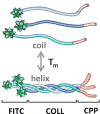Thermoresponsive Collagen/Cell Penetrating Hybrid Peptide as Nanocarrier in Targeting-Free Cell Selection and Uptake
- PMID: 27603918
- PMCID: PMC5177025
- DOI: 10.1021/acs.analchem.6b02438
Thermoresponsive Collagen/Cell Penetrating Hybrid Peptide as Nanocarrier in Targeting-Free Cell Selection and Uptake
Abstract
The effective delivery of therapeutics and imaging agents to a selected group of cells has been at the forefront of biomedical research. Unfortunately, the identification of the unique cell surface targets for cell selection remains a major challenge, particularly if cells within the selected group are not identical. Here we demonstrate a novel approach to cell section relying on a thermoresponsive peptide-based nanocarrier. The hybrid peptide containing cell-penetrating peptide (CPP) and collagen (COLL) domains is designed to undergo coil-to-helix transition (folding) below physiological temperature. Because only the helical form undergoes effective internalization by the cells, this approach allows effective temperature-discriminate cellular uptake. The cells selected for uptake are locally cooled, thus enabling the carrier to fold and subsequently internalize. Our approach demonstrates a generic method as selected cells could differ from the adjacent cells or could belong to the same cell population. The method is fast (<15 min) and selective; over 99.6% of cells in vitro internalized the peptide carrier at low temperatures (15 °C), while less than 0.2% internalized at 37 °C. In vivo results confirm the high selectivity of the method. The potential clinical applications in mixed cell differentiation carcinoma, most frequently encountered in breast and ovarian cancer, are envisioned.
Conflict of interest statement
Notes The authors declare no competing financial interests.
Figures








Similar articles
-
Peptide internalization enabled by folding: triple helical cell-penetrating peptides.J Pept Sci. 2015 Feb;21(2):77-84. doi: 10.1002/psc.2725. Epub 2014 Dec 18. J Pept Sci. 2015. PMID: 25524829 Free PMC article.
-
The Limitations of Collagen/CPP Hybrid Peptides as Carriers for Cancer Drugs to FaDu Cells.Molecules. 2019 Feb 14;24(4):676. doi: 10.3390/molecules24040676. Molecules. 2019. PMID: 30769789 Free PMC article.
-
An efficient PEGylated liposomal nanocarrier containing cell-penetrating peptide and pH-sensitive hydrazone bond for enhancing tumor-targeted drug delivery.Int J Nanomedicine. 2015 Oct 1;10:6199-214. doi: 10.2147/IJN.S92519. eCollection 2015. Int J Nanomedicine. 2015. PMID: 26491292 Free PMC article.
-
Harnessing the power of cell-penetrating peptides: activatable carriers for targeting systemic delivery of cancer therapeutics and imaging agents.Wiley Interdiscip Rev Nanomed Nanobiotechnol. 2013 Jan-Feb;5(1):31-48. doi: 10.1002/wnan.1197. Epub 2012 Sep 13. Wiley Interdiscip Rev Nanomed Nanobiotechnol. 2013. PMID: 22977001 Free PMC article. Review.
-
Tumor-targeting delivery of herb-based drugs with cell-penetrating/tumor-targeting peptide-modified nanocarriers.Int J Nanomedicine. 2018 Mar 9;13:1425-1442. doi: 10.2147/IJN.S156616. eCollection 2018. Int J Nanomedicine. 2018. PMID: 29563797 Free PMC article. Review.
Cited by
-
Hybrid peptides as platform for synchronized combination therapy.Colloids Surf B Biointerfaces. 2023 Jun;226:113326. doi: 10.1016/j.colsurfb.2023.113326. Epub 2023 Apr 24. Colloids Surf B Biointerfaces. 2023. PMID: 37116378 Free PMC article.
-
Higher Order Architecture of Designer Peptides Forms Bioinspired 10 nm siRNA Delivery System.Sci Rep. 2019 Nov 14;9(1):16875. doi: 10.1038/s41598-019-53462-1. Sci Rep. 2019. PMID: 31728030 Free PMC article.
-
Conjugation of Paclitaxel to Hybrid Peptide Carrier and Biological Evaluation in Jurkat and A549 Cancer Cell Lines.ACS Med Chem Lett. 2017 Jul 27;8(8):814-819. doi: 10.1021/acsmedchemlett.7b00117. eCollection 2017 Aug 10. ACS Med Chem Lett. 2017. PMID: 28835794 Free PMC article.
References
-
- Sanhai WR, Sakamoto JH, Canady R, Ferrari M. Nature Nanotech. 2008;3:242–244. - PubMed
-
- Peer D, Karp JM, Hong S, Farokhzad OC, Margalit R, Langer R. Nature Nanotech. 2007;2:751–760. - PubMed
-
- Srinivasarao M, Galliford CV, Low PS. Nature Rev Drug Disc. 2015;14:203–219. - PubMed
-
- Teicher BA. Drug Resistance Updates. 2000;3:67–73. - PubMed
-
- Chari RVJ. Adv Drug Deliv Rev. 1998;31:89–104. - PubMed
Publication types
MeSH terms
Substances
Grants and funding
LinkOut - more resources
Full Text Sources
Other Literature Sources

